Brushing Your 3 Year Old’s Teeth – A Helpful Guide (with pictures)

I was wriggling around the bathroom with toothpaste dripping down my arm and a screaming 3 year old. I thought to myself, “this is not workingâ€. So I decided to search online for a helpful guide on how to brush my 3 year old’s teeth. There had to be an easier way. Surprisingly I couldn’t find one. I found vague websites with “tips†but no easy to follow step-by-step guide on precisely how to brush a 3 year old’s teeth and keep them healthy with the minimum of fuss.
I also wanted to know that I was “doing it rightâ€. I wondered if I was missing doing something. Or maybe worse, doing something that might harm their teeth?
I decided I wanted to try and help other parents with the same problem as me. So I spent hours researching an easy and effective way to brush my 3 year old’s teeth. I made sure to take information only from reputable sources like the ADA American Dental Association). So you know the guide is based on the latest advice.
I’m 100% sure that you will learn something in this guide that will make brushing your 3 year old’s teeth easier and more effective for their dental health. I have done the work for you. So just read on!
WHAT BRUSH SHOULD I USE?
The first place to start when trying to brush your 3-year old’s teeth is to look at what brush you are currently using. I use a small toothbrush (Amazon Link). It is good value, very cute and the head is small enough to get in all the small places around their teeth and gums. I find it much more effective and easier to use than a manual toothbrush. The manual toothbrushes I have tried tend to take longer than my child has the patience for.
The brushes bristles should also be soft. A 3 year old’s gums are much more delicate than yours or mine. The soft bristles can also bend into tight corners, around teeth and just below the gum line to help clean more effectively.
Manual toothbrushes tend to have larger brush heads and are harder to brush effectively in tight spaces, for example in the gum area at the back of their mouth. I find that the small rotating brush heads are much easier to fit in those spaces. I use an electric brush for my own teeth and they feel cleaner than using a manual brush.
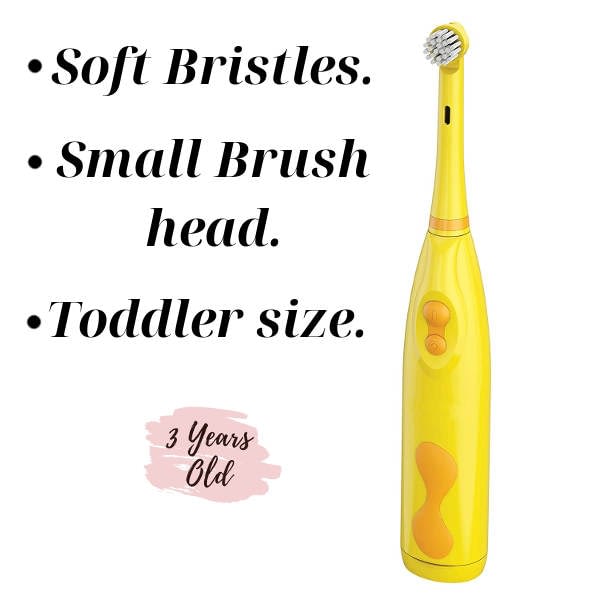
WHAT TOOTHPASTE IS BEST?
I use Tom’s childrens toothpaste with fluoride, it’s great value in a multipack from Amazon. The strawberry taste is subtle, which the kids like. I have found that in some other children’s toothpastes the taste can be very strong and overpowering, which my girls don’t like. It has just the right amount of fluoride for children and is perfectly safe. I feel better knowing that using fluoride, they have the best protection against cavities. Tom’s also do a non-fluoride version (Amazon link) if you feel that is better for you and your 3 year old.
There is debate on using fluoride or non fluoride toothpaste for your 3 year old. I think whenever there is a difference in opinion you should look to the professionals. The ADA (American Dental Association) says:
Fluoride is one of the best and safest ways we can prevent cavities for children and adults alike.
ADA (American Dental Association)
I trust the ADA. The stories you hear about children having horrible cavities when not using fluoride toothpaste in areas with no added fluoride in the water are scary to me.
Fluoride is important because when your 3 year old has any food or drink, natural sugars are spread around their mouth. These sugars feed the bacteria present in their mouth. The bacteria then produce acid that wears away the enamel (the hard outer coating of a tooth). This can lead to decay and cavities. The ADA says:
Fluoride protects teeth by making the your teeth stronger and more resistant to acid. It not only reduces the risk of cavities, it can even help reverse early signs of decay
ADA (American Dental Association)
Fluoride is natural. It is found in natural water sources. By adding it to toothpaste we are just increasing the amount to a level that it is most effective in protecting your 3 year old’s teeth.
The most important tips to remember when brushing with fluoride toothpaste are:
- Use a toothpaste specifically for children. This will have the right amount of fluoride in. Not too much for it to be harmful and not too little that it is ineffective.
- If your 3 year old isn’t good at spitting yet then use a rice sized amount of fluoride toothpaste to limit the amount they can possibly swallow.
- If your 3 year old is good at spitting (Most kids by the age of 3!) then use a small pea sized amount of fluoride toothpaste.
If you follow that simple advice then the ADA says you have nothing to worry about. Better yet, you are doing the best to protect their teeth from cavities.
SHOULD I FLOSS THEIR TEETH?
Yes! I know flossing isn’t that common even amongst adults but the health professionals at Stanford Children’s Health suggest:
Flossing should begin when your child is around ages 2 to 3
Stanford Children’s Health
Just make sure you check with your dentist before you start.
Flossing a 3 year old’s teeth is tricky. They like to wriggle and squirm. Most 3 year old’s will not enjoy the sensation at first. After a week or so I found that they accepted it and wriggled a lot less. Now they aren’t that bothered by it at all when I do it. So my advice is to persevere.

I use specially designed kids floss picks (Amazon link). They are much easier to handle than floss on a roll (which would be pretty much impossible to use on a 3 year old!). They have a big grip and a tasty berry flavor. I’ve tried a few different brands, but those were the easiest to use.
The Stanford Children’s Health website says you should floss their teeth at least once a day.
Flossing should take place at least once a day for two to three minutes each time to be most effective.
Stanford Children’s Health
I always floss for them at night. I find it easier at that time and it is satisfying getting all the little bits of food out from between their teeth.
A COMPLETE GUIDE TO BRUSHING YOUR 3 YEAR OLD’S TEETH
Using information from the ADA (American Dental Association) and Stanford Children’s Health I have put together what I think is the most complete guide to brushing your 3 year old’s teeth.
1. Make sure you have the correct toothbrush, toothpaste and floss pick. I have gone into detail in the sections at the start of this guide about what I use.
2. Take your 3 year old into the bathroom. Ideally you want to do this in front of a mirror so they can see you and learn about how you are going to keep their teeth nice and clean. Make sure you get them to stand in front of you. You will be looking over their head or just to one side of their shoulder.
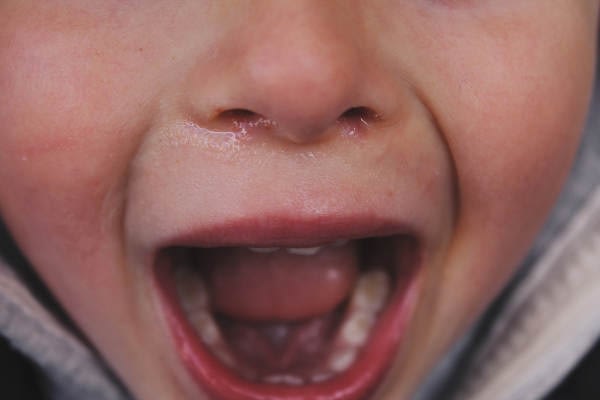
3. Take their toothbrush and add the correct amount of children’s fluoride toothpaste to the brush. The correct amount (According to the ADA) is:
- If your 3 year old has trouble spitting: An amount the size of a grain of rice. This is to prevent them from swallowing too much of the paste by accident.
- If your 3 year old is confident at spitting: An amount the size of a pea.
4. Once you have the correct amount of toothpaste on the brush. I like to wet the brush head and toothpaste a little under a slow running tap. I find this makes starting the brushing easier as the brush head and paste can be a little dry when you first start.
5. You then need to reach over their shoulder and open up their mouth gently with one hand and use the brush with the other. It’s easier if they tilt their head back slightly.
6. We are going to separate their teeth into four areas (See the diagram below). The reason why I do this is to make sure I don’t miss any part of their teeth or gums. If you are used to brushing their teeth, going from one side to the other. Then you are probably missing out parts accidentally.
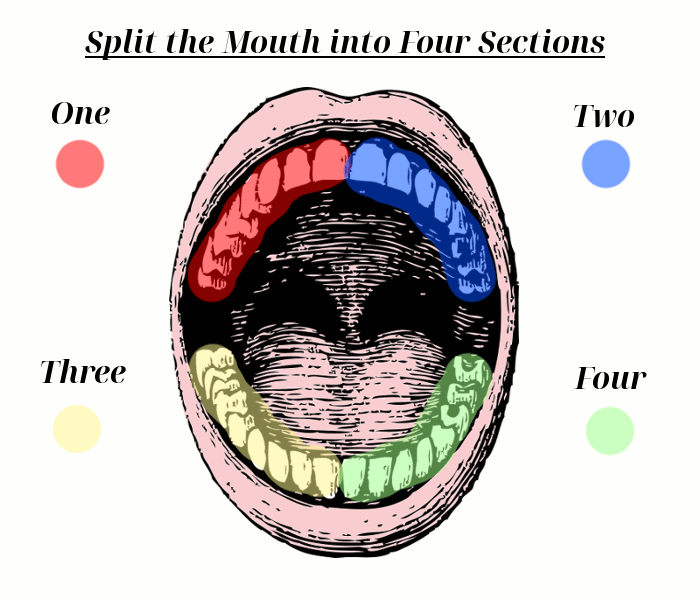
If you are worried that you might be missing out on parts of their mouth which you should be brushing. You can get revealing tablets (Amazon link). These tablets highlight plaque in your child’s mouth. These are areas which you will need to make sure you are brushing more thoroughly in the future to avoid decay. Only use these tablets if you feel like your 3 year old will be able to chew them rather than swallowing them. (Otherwise they won’t work!).
7. Once you have understood the four different areas of the mouth. I want you to brush each area one at a time. Do not brush multiple areas at once. Finish one area first then move on to the next. This will make sure that you don’t miss anything.
8. Then start to brush the first section of their mouth:
- First: Brush the outer surface of the teeth.
- Second: The gum line on the outer surface. For this section, angle the brush at 45 degrees to the gum.
- Third: Then move on to the chewing surfaces.
- Fourth: Move to the inside surfaces of the teeth (next to their tongue) and don’t forget the gum line on that side too.
You want to brush their teeth in an up and down motion. Making sure the brush head is moving in small circular motions. Brushing their teeth like most people do in a side to side motion is not recommended by the ADA (American Dental Association). It can even damage teeth and gums.
9. After completing two of the four sections of their mouth take a break. It’s best to encourage them to spit at this point to make sure the brushing hasn’t created too much foam which they might swallow.
10. Then complete the last two sections of the mouth one at a time using the same method as I described above.
11. Once you have completed all four sections of the mouth. I then get them to spit into the sink again. This gets rid of the last bits of toothpaste from their mouth.
12. Once the brushing is done. Then it is time to use one of the floss picks. Gently floss between every tooth in their mouth. Stand behind them in the same position as brushing. They can tilt their head back slightly to make it easier for you to access all their teeth.
13. Once you have flossed every part of their mouth. I then give them a cup of water to wash all the last bits of toothpaste and food away. I don’t use any mouth rinse products because I am too worried they will accidentally swallow them.
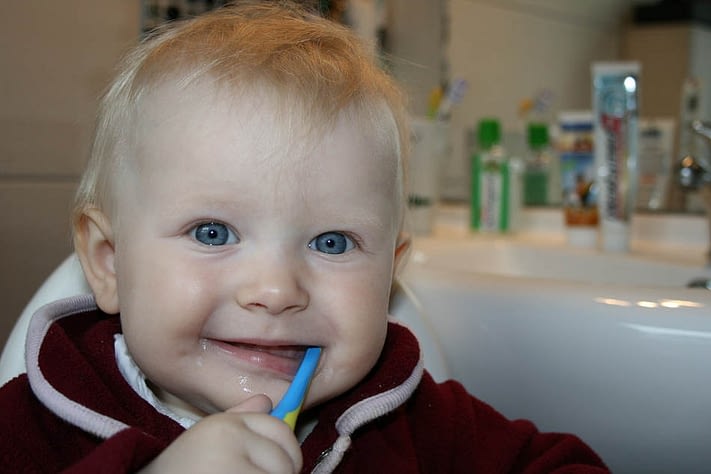
ESSENTIAL TIPS FOR BRUSHING YOUR 3 YEAR OLD’S TEETH
1. Choose the right brush: Make sure you have chosen the right brush. I wrote a section on choosing the right brush in this article. It is very important. Make sure it is soft and small enough to get into all the problem areas. If the brush is too hard it can irritate their sensitive gums.
Hard bristles can actually wear down the delicate enamel on the outside of the tooth. Soft bristles are much more effective at cleaning and gentler on their mouth.
2. Don’t press too hard: It’s natural to want to get their teeth as clean as possible. I know I have made the same mistake of brushing too hard to try and achieve that. Hold the brush lightly and press it gently onto the surface of the teeth. It should only take enough strength just to hold it in place. Plaque is soft, you don’t need to press hard. You risk wearing down the enamel on their teeth or irritating their gums.
3. Brush for 2 mins: Don’t rush your brushing. Make sure each time your brush their teeth it lasts for at least two minutes. I would suggest using the stopwatch on your phone the first few times. It will give you an idea of how long two minutes brushing actually is. We will be aiming for around 30 seconds per section of the mouth.
After a while you will get to know about how long two minutes is. Then to remind myself I sing a song to them. One that I know lasts around two minutes. If you don’t like singing then just sing one in your head.
4. Change your brush: Don’t hold on to their brushes too long. The ADA (American Dental Association) says to:
Replace toothbrushes every three to four months or more often if the bristles are visibly matted or frayed.
ADA (American Dental Association)
5. Store their brush in the open air: Make sure you are storing their brush in the open air. This means it will dry in between brushings. Bacteria can grow on damp toothbrushes that aren’t able to dry in between uses.
6. Don’t forget your gum line: Brushing their teeth includes their gums too. Where their teeth meet the gum line is the area to concentrate on. The reason why is because the soft bristles can bend into the gum and clean any plaque that has made it just beneath the gum line. A 45 degree angle for your brush is perfect for thoroughly cleaning their gum line.
7. Don’t forget the inside surfaces: The inside surfaces (tongue side) are the easiest parts of their mouth to forget to brush. Make sure you pay just as much attention to these parts as you do for the outside.
8. Don’t brush within 20 mins of eating: If they have just eaten food or had a sugary drink. The bacteria in their mouth will be producing the acid that wears away their teeth. Their enamel is softer at this time. So brushing your teeth can cause the enamel to be worn away more than usual. Give it 20 minutes after eating before brushing their teeth. This gives their mouth time to produce enough saliva to make it less acidic. You can also get they to rinse their mouth with water which will speed up this process.
If you would like to know more about your 3 year old’s teeth then have a read of the article I wrote about cutting teeth and dental hygiene. It has lots of great information about what you should expect and the best time to start their dental health regime.
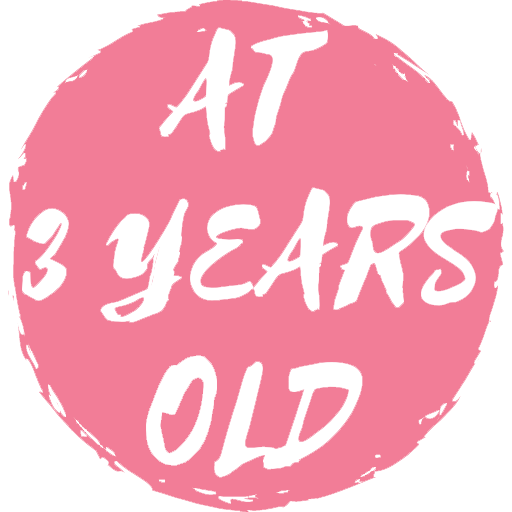
Leave a Reply